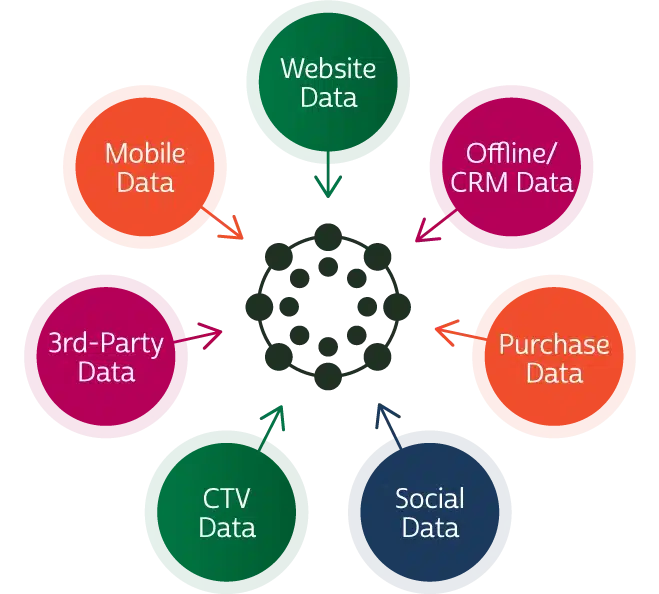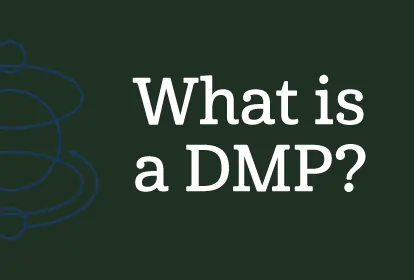As digital media grows more complex and more user data is created and collected on a daily basis, marketers, agencies and publishers need better ways to buy, sell and manage audience data beyond the standard suite of analytics tools. How do you capture all this valuable audience data, shape it into insights and then activate it to drive outcomes?
Jump to:
- What is a Data Management Platform (DMP)?
- How Does a DMP Work?
- What Do You Do With a Data Management Platform?
- DMPs vs CDPs vs DCPs
What is a Data Management Platform (DMP)?
A data management platform (DMP) is a unifying platform to collect, organize and activate first-, second- and third-party audience data from any source, including online, offline, mobile, and beyond. It is the backbone of data-driven marketing and allows businesses to gain unique insights into their customers.
While big data is instrumental to effective data-driven marketing campaigns, you can’t do much with the raw information. You need it sorted and converted into a usable form, at least so you can understand what you’re looking at. This is the power of a DMP.
What Does a DMP Do?
A DMP collects and organizes data from a variety first-, second- and third-party data sources, and makes it available to other platforms such as DSPs, SSPs, and ad exchanges to be used for targeted advertising, personalization, content customization and beyond. Some people describe a data management platform as the “pipes” of ad tech — connecting many platforms in a neutral way so marketers can use their powerful audience data when and where they want.

How Does a DMP Work?
A DMP can collect unstructured audience data from any source, including desktop, mobile web, mobile app, web analytic tools, CRM, point of sale, social, online video, offline and even TV. A true DMP should collect audience data on more than a surface level, going far beyond things like URL and keyword information.
This first-party data — that is the data you own and have collected directly from your own customers — can be collected based on specific behaviors such as clicks, downloads, video uploads or video completions, interests like sports, football, parenting, museums and travel or demographic information. It can also include demographic data, socio-economic data, influencer and action data. As an example, a business can use a DMP to collect and organize data, then use that data to target a particular ad to moms who are 25-35, there are endless applications of a DMP.

Lotame’s data collaboration platform, which has capabilities beyond a traditional DMP, enables the collection of audience data from the following online and offline sources:
- Web analytics tools
- Mobile web
- Mobile apps
- Behavioral and demographic data
- CRM data
- Point-of-sale data
- Social networks
- Online video
- TV data
- and more!
What Happens Once the Data is Collected?
Once the first-party data is collected, it is organized into a series of segments called a “hierarchy”, which can change based on each end user’s business models. A large publisher network may have their hierarchy divided up into different buckets based on each of the individual websites they own. An agency can have separate accounts for each of their advertiser clients. Marketers could manage different brands’ data separately, while also having an overall holistic view of the data at the top level.
All of this data, once categorized, can be used to better understand your audience, create effective RFP responses, enrich your audience to learn more about them and extend your audience reach to address campaign commitments. In short, all of your audience data is collected in one place for a quick and easy understanding of who your best customers are, what content they interact with, and how best to reach them effectively.
There are 4 basic steps to getting started with a DMP; let’s review them here.
1. Organization
A DMP will organize your first-party audience data into categories and taxonomies, which are specified by those using the platform — in this case, that would be you. You define how that data is organized, which means you need to understand — and define — what you need out of your data before deploying a DMP.
2. Segmenting and Audience Building
Once the data is organized into the platform into segments, you can use this information to build audiences for specific marketing campaigns. For example, a retailer may want to target one particular ad to females 18-34 while another may be focused on men who frequently buy shoes online. Regardless of who they are trying to reach, marketers, publishers and advertisers rely on audience segmenting to power their data-driven campaigns and reach the right consumers at the right time.
3. Insights and Audience Profile Reports
Soon after the data has been organized and classified, you can take chunks and analyze it to discern customer patterns, trends and intent.
Audience Profile Reports give an in-depth view of the characteristics and interests of each “audience” that has been built in the platform. This information can be used to inform your future creative and messaging.
4. Activation
The final step is to activate the data, by putting it to work! This activation step relies on the DMP having integrations and open APIs with other platforms, so that the audiences you build in the DMP can be seamlessly transported to DSPs, SSPs, and beyond. The most common DMP use case is running a targeted campaign to a specific audience via a DSP. Or, you can connect the DMP to your content management system (CMS) to adjust the content of your website for certain audience groups. The possibilities and use cases for data activation with a DMP are limitless.
How Do I Build a DMP Audience?
Once you’ve collected and organized your data, it’s time to build unique audiences in your DMP so you can identify your most valuable segments and use them across any digital channel. For any particular targeted campaign, a marketer can predefine the target audience for that campaign based on data gathered from your DMP audience. So instead of choosing to spend your advertising dollars on a particular financial website to reach an audience of folks interested in finance, you can instead build a financial audience based on actual behaviors across the wider Internet.
Audiences can be built inside the data management platform using any combination of first-, second- and third-party data sources, which are combined using Boolean logic, which breaks down all values into either true or false. You can build as niche an audience as you wish, and are only really limited by the scale you need. Generally, the more niche the audience, the smaller the size.

What Data Points Can I Use to Build an Audience?
You probably already know your audience demographics and targets, and that is a good place to start when building audiences. Here are just a few of the data points you can use to build your audience:
- Age
- Gender
- Location or region
- Interests
- Browsing history
- Household income
- Family size
- Opinions — e.g., all customers who like/do not like X
- Social networks — e.g., Facebook versus Twitter
If you don’t have adequate first-party data to build the audiences you need, the DMP should provide access to 2nd- and 3rd-party data to help scale your campaigns to reach your audience goals.
Who Can Benefit From Using a Data Management Platform?
Professionals and businesses from every industry around the globe can benefit from a DMP. Upper or C-level management might rely on a DMP to make smarter and more informed decisions. IT or networking professionals might rely on a DMP to maintain and operate a companywide system, gaining insights from the tool that can be used to choose machines, software and more.
The basic business cases for a DMP can be separated into three groups: publishers, marketers and agencies.

Publishers or media owners include anyone who own and manage websites. Publishers use data management platforms to manage the audience data collected from all of their websites and the data-driven advertising campaigns run across those sites. A DMP enables publishers to capture first-party audience data and enrich it with additional audience insights, allowing the publisher to increase CPMs for both direct sold and programmatic inventory. Because publishers collect rich audience data from their websites, many of them opt to sell customer data via a 2nd-party marketplace or a 3rd-party data exchange.
Marketers and agencies use data management platforms to identify and classify audiences at a significantly deeper level and to gather an extra layer of data about their audience, regardless of the data source. These insights into your most valuable customers allow marketers to identify and target prospects who look and act exactly like them so you can increase your audience base. They then fuel high-performing data-driven marketing campaigns with these audiences, so they can be sure to reach the right audience at the right time on the right device.
What Can I Use a DMP for In Marketing?
Now that we understand what a DMP is, the next question is how to implement it into your marketing strategy? The good news is, you shouldn’t have to change a thing.
Once the DMP starts collecting your data, you should be able to profile your existing customers and audience, extract meaning from your data, and improve campaigns for maximum marketing campaign performance.
A DMP should be the core of your marketing processes and strategies. The DMP can help you understand which advertising and marketing materials will resonate with your audience most, what content will get the most engagement from your customers and audience, and what message will inspire them to buy your products or pay for your services.
Suddenly your dreams of data-driven marketing can come true, and you can use the DMP to influence your campaigns for increased success.
What Do You Do With a Data Management Platform?
More important, however, is what you can do with all that data you collect. Here are just a few things you can focus on and what you can do with them:
- Audience targeting and targeted advertising: Specify your audience and target their interests and needs via video, visuals and content
- Content and product recommendations: Deliver personalized experiences for web and mobile users
- TV DMP: Match your audiences across TV & digital so you can reach the same audience when and where they are ready to buy
- Monetizing or selling data: Sell your valuable data for additional revenue
- Audience enrichment: Learn more about your audience, beyond what they do when they’re on your website or other properties.
- Grow your audience or customer base: Find a healthy supply of new customers to build brand loyalty
- Paid search: Use DMP-driven audiences to target, suppress or dynamically update paid search campaigns
- Paid social: Execute DMP-driven audience buys within social environments using Facebook and Twitter’s respective custom audience solutions
Out of all those scenarios — especially in e-commerce and marketing — delivering a personalized experience to your customers is one of the most important. You build a rapport or relationship with your customers by focusing on their interests and needs. Using data to personalize their experience is a great way to do that. It’s why brands like Amazon offer “recommended” sections with products similar to what a customer has viewed in the past.

Chances are, you’re already sitting on a mountain of valuable data. Most people understand the importance of collecting data and storing it for later. Unfortunately, storing and saving data is different from using it.
A DMP can help you turn that mountain into a goldmine!
DMPs offer the ability to reach the right customer, at the right time, on the right screen, for maximum campaign performance.
DMPs vs CDPs vs DCPs
The ad industry is transforming rapidly, with a continuous influx of new data solutions. From legacy DMPs to the current Customer Data Platforms (CDPs) and the emerging Data Collaboration Platforms (DCPs), it’s a lot for a digital marketer to keep track of. Below, we’ll take a closer look at the core functions, advantages, and limitations of DMPs, CDPs, and DCPs, shedding light on how they’ve evolved and where they’re headed.

Data Management Platforms (DMPs):
- Core Function: Primarily used for advertising, focusing on collecting, organizing, and activating first, second, and third-party data (data collected from various sources unrelated to the company).
- Strengths: Enabled broad audience targeting and ad personalization.
- Weaknesses: Most DMPs heavily relied on third-party cookies, which are now being phased out due to privacy concerns. This, coupled with evolving privacy regulations, has led to their decline. This is one of the reasons why Lotame has evolved its technology beyond the traditional DMP, to a solution that offers cookieless targeting, second-party data collaborations, and first-party data enrichment.
- Current Status: Largely abandoned by major players like Salesforce, Adobe, and Oracle.
Customer Data Platforms (CDPs):
- Core Function: Centralizes and manages first-party customer data (data collected directly from customers) across various marketing channels and touchpoints.
- Strengths: Powers personalized marketing campaigns, customer journey analysis, and owned channel management.
- Weaknesses: While valuable, they don’t fully address the challenges of a cookieless future in advertising, as they mainly focus on owned data.
- Current Status: Still relevant for managing owned data and marketing campaigns, but their role in advertising is evolving. CDPs are increasingly being used in conjunction with other technologies that are able to address the challenges of a cookieless world.
Data Collaboration Platforms (DCPs):
- Core Function: Facilitates secure and private data collaboration between different companies and platforms, particularly in the advertising ecosystem. Lotame’s data collaboration platform is an all-in-one solution that allows digital marketers to collect and connect, enrich, model, collaborate and activate data.
- Strengths: Addresses the fragmentation caused by the decline of third-party cookies. Enables interoperability between different ad networks, publishers, and identity providers. Aims to make first-party data sharing more seamless and effective for advertising.
- Weaknesses: DCPs are still an emerging category; industry standards and best practices are still evolving to meet the needs of a rapidly changing advertising ecosystem. More education among digital marketers is critical for innovation.
- Current Status: Gaining traction as a promising solution for the future of data-driven advertising in a privacy-focused landscape.
Key Takeaways:
- DMPs are a legacy technology of the past, relying heavily on third-party cookies which will soon be obsolete.
- CDPs are the present, focusing on owned data and marketing optimization.
- DCPs represent the future, aiming to solve the data fragmentation and interoperability challenges in advertising caused by the demise of third-party cookies.
Why Lotame?
Lotame has evolved its DMP far past the capabilities publishers and marketers associate with the acronym. We believe connected data is the key to a cookieless world. Guided by that North Star, our continuous commitment to innovation enables us to offer the benefits of a traditional DMP plus much more, including the ability to connect first-party audiences across browsers, devices, and platforms and collaborate with partners of your choice. Our identity-powered Spherical platform is an end-to-end data collaboration platform that future-proofs data connectivity today, and in a post-cookie world.
By tapping into our technology, marketers, agencies, publishers, and platforms can continue to onboard, enrich and address audiences even as third-party cookies are phased out. Request a demo of our data connectivity solutions to learn how you can start growing yield, increase performance, and respect consumer choices.


